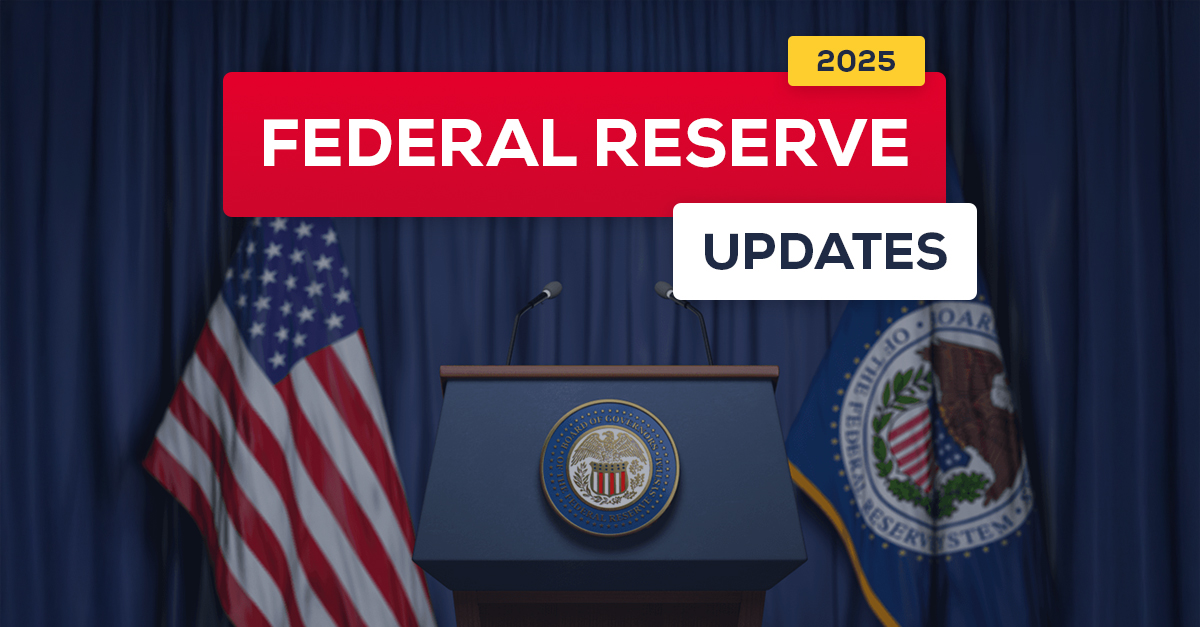Federal Reserve Meeting Updates: 2025 Rate Decisions & Insights




Stay tuned here after every Fed meeting for the latest on rate decisions, press conference highlights, and economic implications.
December 10, 2025 – Third Straight Cut as Fed Balances Cooling Inflation and Softening Labor Data
At the December meeting, the Federal Reserve opted for a cautious move in the absence of an official October jobs report. With some softening in labor-market signals and inflation gradually cooling, the Committee decided to cut the federal funds rate by 25 bps, putting the target range at 3.50% – 3.75%. Policymakers emphasized that while inflation is drifting lower, significant downside risks remain around employment and signaled that future moves will remain conditional on upcoming data.
Equities initially responded strongly. Treasury yields eased slightly and futures now price in a moderate chance of one or two more cuts in the coming quarters, though much depends on how economic data unfolds. Fed officials’ median projections pointed to one cut in 2026, and one in 2027. Rate projections for 2026 remain deeply divided among Fed officials, however.
As rates fall, banks don’t give up revenue – they reallocate it. Lower interest income puts upward pressure on service-based pricing, which is why fee inflation often accelerates during easing cycles. The December Fed move reinforces this: while benchmark rates decline, deposit yields, ECRs, and credit spreads rarely fall in sync, creating a gap that compresses liquidity returns. Treasury teams should expect fee increases, benchmark aggressively, and negotiate early, as annual adjustments typically hit between January and March. In a lower-rate environment, disciplined fee management and proactive engagement with banking partners are essential to preserving yield and controlling cash-management costs.
October 29, 2025 – Second Straight Cut Amid Data Gaps and Slowing Momentum
The Federal Reserve lowered rates by 25 basis points to 3.75 % – 4.00 %, marking a second consecutive cut as policymakers sought to support slowing growth amid mixed economic signals. Chair Powell acknowledged continued cooling in the labor market and consumer spending but noted that missing government data from the federal shutdown limited visibility into key indicators.
The decision was widely expected, reinforcing the Fed’s data-dependent stance heading into year-end. Policymakers signaled that further easing remains possible should conditions soften, though several officials cautioned against moving too aggressively without clearer inflation and employment data. Markets reacted modestly, with Treasury yields easing slightly and equities showing a muted gain, as investors largely anticipated the move and continued to price in the potential for another adjustment before year-end.
Rate cuts don’t flow through the banking system evenly. Deposit yields and SOFR typically adjust quickly, while credit spreads respond more slowly as banks reassess risk. Sometimes spreads will be increasing while reference rates are decreasing in response to economic weakness. And with many companies borrowing under a fixed interest rate (or swapped), they will see liquidity returns compress faster than borrowing costs, creating a gap that can quietly erode performance. Treasury teams should use this phase to renegotiate terms, benchmark bank responsiveness, and identify early movers.
September 17, 2025 – Long Anticipated Rate Cut at 25 bps
The Federal Reserve lowered its benchmark rate by 25 basis points to 4.00% – 4.25%, the first cut of 2025. Chair Powell pointed to cooling economic momentum: slowing payroll growth, rising unemployment, and weaker factory activity. Inflation remains above the 2% target, but officials are still unclear about the short to medium term impact of tariffs on pricing.
Updated projections indicate two more cuts could follow by year-end, but the Fed stressed data dependence. The decision was not unanimous – Governor Stephen Miran dissented in favor of a 50 basis point cut, underscoring division on how aggressively to act. Markets had largely priced in the move, with yields dipping modestly and futures now assigning high odds to another cut at the October meeting. Tariffs and sticky core inflation remain risks that could slow the easing path.
Lock your deposits but watch your financing windows closely. Financing rates will not necessarily move in step with the Fed as lenders and investors may factor in added risk from a softening economy. The potential benefit of waiting to refinance could be partially or entirely offset if corporate ratings and the broader outlook deteriorate. Now is the time to reassess exposures, act on favorable windows, and prepare for an uneven easing cycle.
August 1, 2025 – Fresh Data Renews Market Bets on September Cut
Just days after the Fed’s July 30 decision to hold rates steady, markets were rocked by weaker-than-expected jobs and manufacturing data. The July payroll report showed only 73,000 new jobs added, far below expectations, while prior months saw major downward revisions. Unemployment also ticked up to 4.2%, and factory employment hit a five-year low. As a result, market odds for a rate cut in September have surged past 75%, reversing the post-meeting dip in expectations and increasing pressure on the Fed to pivot sooner than anticipated.
July 30, 2025 – Fed Holds Rates Steady & September Cut Less Certain
The Federal Reserve held interest rates at 4.25% – 4.50% for a fifth straight meeting, as there are risks to both sides of the Fed mandate: moderating economic growth, but “somewhat elevated” inflation and a “very good” labor market. Powell indicated that most measures of longer-term expectations point toward the Fed’s 2% inflation target even as he indicated that inflation was somewhat “above target.” He acknowledged potential impacts from tariffs on goods prices even as services inflation eases, but there remains significant uncertainty. He is “going to need to see the data” before making a decision about September and would like to see data quality improvements.
Two Fed Governors dissented for the first time since 1993, favoring an immediate rate cut, highlighting growing internal divergence or perhaps an effort to position to be the next Fed Chair. We expect to see public commentary from the dissenters as early as Friday. Powell was more hawkish than the official statement in the press conference, indicating that you could argue that the Fed is “looking through” tariff impacts by not hiking rates now.
Stocks fell during the Q&A portion of his speech, as his answers were more hawkish than indicated in the statement and Treasury yields edged slightly higher. Expectations for the September cut declined from 68% yesterday to 48%, The Fed’s balance sheet runoff will continue. The stronger than expected GDP number will increase focus on Friday’s payroll number, but tariff disruptions make the situation somewhat unclear as companies accelerated imports ahead of expected tariffs, weakening GDP, and the recent bump certainly contains some impact of a reversal of the import impact. The market is also focused on big tech earnings with strong releases helping the market to pare some losses after the close.
Powell continues to support the independence of the Fed and declined to answer whether he will leave once his term as chair ends.
The Fed remains data dependent, and the probability of rate cut in September is uncertain. For treasury and finance leaders, this is a key window to reassess fixed vs. floating exposures. Borrowing costs and investment yields may shift quickly if expectations turn into action. Don’t wait for confirmation, follow the data and prepare now for a lower-rate environment which could lower investment returns and interest rates.
June 18, 2025 – Fed Holds Rates at 4.25% – 4.50%
The Federal Reserve decided to keep interest rates steady at 4.25 – 4.50%, marking the fourth consecutive meeting without a change. The Committee noted that recent data shows the U.S. economy expanding at a solid pace, with a strong labor market. However, inflation remains “somewhat elevated,” and uncertainty, particularly around trade and tariffs, continues to cloud the outlook. The Fed confirmed it will continue reducing its Treasury and mortgage-backed securities holdings, maintaining its quantitative tightening campaign
In the press conference, Chair Powell emphasized that the Fed is in “no hurry” to move, echoing a cautious stance amid mixed signals. The updated dot plot continues to forecast two rate cuts by year-end, though a growing number of officials now see no cuts in 2025. Markets largely took it in stride, Treasury yields dipped slightly, while stocks showed limited reaction.
Yields on cash and debt may remain sticky, even as inflation cools. Be proactive with your negotiations. Also, watch for windows to lock in your rates. Volatile expectations can create short-lived opportunities to optimize your cash returns and raise capital.
May 7, 2025 – No Change; Elevated Uncertainty
At its early May meeting, the FOMC held rates steady at 4.25 – 4.50%, citing rising risks to both sides of its dual mandate. Chair Powell acknowledged that while the economy remains healthy, mounting tariff pressures could increase inflation and joblessness simultaneously, a stagflation risk. The Fed’s statement noted that uncertainty “has increased further,” leading it to maintain a patient stance.
According to the meeting minutes, almost all participants flagged persistent inflation and growing downside risks to employment. The labor market remains strong, but mixed economic indicators have pushed the first anticipated rate cut from June to September or later, according to analysts.
Even when rates don’t move, market expectations drive shifts in borrowing costs, liquidity access, and cash yields. It’s not ‘wait and see’, it’s ‘react and reprice.’ For finance teams, understanding how rate signals influence bank behavior is key. In volatile cycles, timely insight can make all the difference.
March 19, 2025 – Paused as Inflation and Growth Signals Warrant Caution
At the mid-March meeting, the Fed again paused, keeping rates at 4.25 – 4.50%, amid a split in internal views, one vote dissented, and most officials favored waiting for more data. The Committee highlighted that inflation remained above target and uncertainty persisted, though recent economic activity had shown resilience.
Forward guidance in the post-meeting materials continued to forecast two rate cuts this year, but those remain conditional on incoming data. Powell’s comments reinforced the Fed’s balanced approach: “we don’t feel we need to be in a hurry,” underscoring a data-dependent posture.
Expect banks to pass more costs onto clients. Don’t wait for the Fed to move, your banks already are. We’re seeing big shifts in pricing behavior.
January 29, 2025 – First Meeting of the Year, No Change
The Fed began 2025 with a status quo decision, maintaining the rate at 4.25 – 4.50% and noting that inflation and employment are “roughly in balance”. There were no changes to reserve or repo operations, and interest on reserves remained at 4.4%.
In his opening remarks, Chair Powell emphasized flexibility: the Fed would act if needed, but would await clearer economic signals. This tone reinforced a prudent approach, neither hawkish nor dovish, and set the stage for cautious monitoring of inflation trajectory.
As the Fed holds rates steady, it’s expectations, not action, that drive movement in borrowing costs and yields. Treasury teams should stay closely attuned to shifting rate sentiment and market pricing, as these can impact funding and investment decisions well before any official change. Keeping a pulse on forward-looking indicators is just as critical as tracking policy itself.